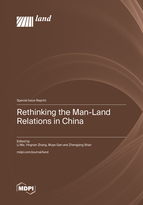Rethinking the Man-Land Relations in China
A special issue of Land (ISSN 2073-445X). This special issue belongs to the section "Land Systems and Global Change".
Deadline for manuscript submissions: closed (15 April 2023) | Viewed by 37187
Special Issue Editors
Interests: multifunctional land use; land use transition; farmland transfer
Special Issues, Collections and Topics in MDPI journals
Interests: land use conflicts/trade-offs; rural land reform; agrarian change in China
Special Issues, Collections and Topics in MDPI journals
Interests: urban ecology and remote sensing application; ecosystem services modeling and trade-off analysis
Special Issue Information
Dear Colleagues,
Land is an essential natural resource, both for the survival and prosperity of humanity, and for the maintenance of all terrestrial ecosystems. Through much of the course of human history, as a fundamental factor of production, it has been tightly coupled to economic growth. As a result, control over land and its use is often an object of intense human interactions. Man-land relationship reflects the interdependence and interaction between man and nature. China has experienced a great transition-the unprecedented urbanization, industrialization, and globalization, which presents man-land relations with new challenges on many fronts. Creating the built environment to house urban populations and their activities is one of the fundamental aspects of urbanization. This dynamic adds pressure to potentially strained food systems and threatens livelihoods in vulnerable regions. In fact, this is only a miniature of the changing man-land interactions in China. The complex interactions between humans and land are so broad that encompass excessive intensification of agricultural land, land degradation, farmland abandonment, emerging "hollow villages", land fragmentation, urban renewal, congested traffic, a housing shortage, etc. There is currently insufficient research into the changes in man-land relations in China. It is necessary to use different lenses to examine various aspects of how human disturbances influence land use system and how land use changes affect human well-being. Therefore, a reconsideration of man-land relations in this rapidly changing age should be put on the agenda.
This special issue seeks to reexamine these changes in man-land relations in transitional China, and rethink our understanding of the human-environment interactions of both urban and rural areas, thus advancing theories in land use science as a major component of land management and sustainability science.
Potential topics include, but are not restricted to, the following:
- Regularities of the evolving man-land relations
- Telecoupled land-use changes
- Architecture of the global man-land interactions
- Land use transition and its environmental effects
- Land use conflicts/trade-offs
- Land degradation
- Multifunctional land use
- Urban sprawl and regeneration
- Urban-rural migration and housing affairs
- Urban infrastructure
- Rural land use
- Land system reform
- Farmland transfer
- “Non-grain” utilization of cultivated land and food security
- Landscape and ecological system service
- Big data technology and Remote Sensing applied in the above-mentioned fields
Dr. Li Ma
Dr. Yingnan Zhang
Dr. Muye Gan
Dr. Zhengying Shan
Guest Editors
Manuscript Submission Information
Manuscripts should be submitted online at www.mdpi.com by registering and logging in to this website. Once you are registered, click here to go to the submission form. Manuscripts can be submitted until the deadline. All submissions that pass pre-check are peer-reviewed. Accepted papers will be published continuously in the journal (as soon as accepted) and will be listed together on the special issue website. Research articles, review articles as well as short communications are invited. For planned papers, a title and short abstract (about 100 words) can be sent to the Editorial Office for announcement on this website.
Submitted manuscripts should not have been published previously, nor be under consideration for publication elsewhere (except conference proceedings papers). All manuscripts are thoroughly refereed through a single-blind peer-review process. A guide for authors and other relevant information for submission of manuscripts is available on the Instructions for Authors page. Land is an international peer-reviewed open access monthly journal published by MDPI.
Please visit the Instructions for Authors page before submitting a manuscript. The Article Processing Charge (APC) for publication in this open access journal is 2600 CHF (Swiss Francs). Submitted papers should be well formatted and use good English. Authors may use MDPI's English editing service prior to publication or during author revisions.
Keywords
- man-land relations
- land use/land cover change
- land use transition
- urban land management
- rural land use
- tele-coupling
- sustainable land use









